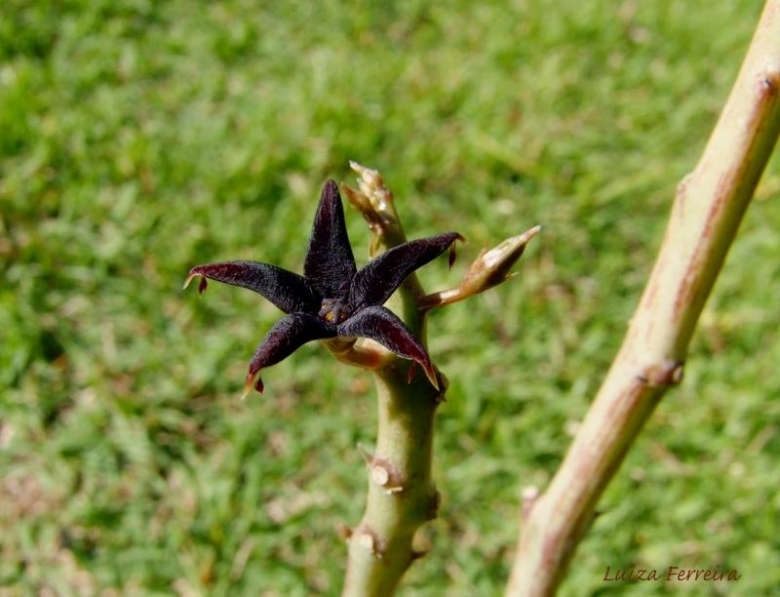Your support is critical to our success.
- /Encyclopedia/SUCCULENTS/
- /Encyclopedia/SUCCULENTS/Content/
- /Encyclopedia/SUCCULENTS/Family/
- /Encyclopedia/SUCCULENTS/Genus/
- /Encyclopedia/SUCCULENTS/Species/all/
Since 4 Aug 2013
Bull. Misc. Inform. Kew 1925(10): 430. [22 Dec 1925]
Family: ASCLEPIADACEAE

: Caralluma stalagmiferaSN|31349]]SN|31338]] is distributed over the greater part of Southern India (Indian Subcontinent, Asia-Tropical). It occurs with Caralluma adscendensSN|31341]]SN|31341]] var. attenuata over the greater part of its range, but does not seem to extend so far west, and south into the area occupied by the Caralluma carinataSN|31338]]SN|31349]] group. The type locality is Vandalur in Chennai, formerly Madras in Tamil Nadu.
Habitat and ecology: This species grows in dry and rocky regions.
:
- Caralluma stalagmifera C.E.C.Fisch.
Caralluma stalagmifera C.E.C.Fisch.
Bull. Misc. Inform. Kew 1925(10): 430. [22 Dec 1925]
: 3
- Caralluma stalagmifera C.E.C.Fisch.
- Caralluma stalagmifera var. intermedia Karupp. & Pull.
- Caralluma stalagmifera var. longipetala Karupp. & Pull.
ENGLISH: Dark Purple Caralluma
: The Dark Purple Caralluma (Caralluma stalagmifera) is a perennial succulent plant growing up to 25-40 cm tall, in dense clumps. The flowers are tiny, star shaped, dark purple with purplish yellow tips, after 8-12 days flower colour changes to brownish-green.
Stems: Succulent, hairless, with clear exudates, slightly branched up to about 60 cm long, tapering towards the tip, 5-20 mm in diameter, square in cross-section with rounded edges. The upper portion of the stem, which forms the inflorescence, is almost round. Greenish to greyish-green with brown mottling, the edges often reddish brown.
Leaves: Small, narrow and triangular or tooth-like, stalkless, 2-3(-5) mm long, 0.5-1 mm wide.
Inflorescence: Axillary, usually only one-flowered, occasionally with two flowers. Bracteoles, small, subulate-triangular. Peduncle slender, about 5-15 mm long and 1 mm in diameter, hairless.
Flowers: Hermaphroditic, with radial symmetry. Sepals five, 1.5-2 mm long. Calyx is five-lobed, divided up to base. Corolla, fleshy, wheel-shaped, about 12 mm long 8-10 mm in diameter, greenish outside, inside uniformly dark cream to dark purple. Petals fused basally ovate-lanceolate, dark purple with purplish yellow tips, after 8-12 days flower colour changes to brownish-green, basal parts of some flowers light pale yellowish with dark markings at the petal. Tube shortly funnel-shaped. Corolla tube cream-coloured. Perianth segments oval-lanceolate, the edges folded outward and the insides with a silky shine. Rims of the segments and apex ciliate, with vibratile, spindle shaped or clavate hairs, up to 2 mm long, white to dark purple coloured, caracteristically hanging down like stalagmites (hence the species name!). The corona is biseriate dark purple. Outer lobes, erect, linear-lanceolate. Pollinia 0.25 × 0.3 mm.
Blooming season (in habitat): December-June.
Fruits (follicles): Paired, round in cross section, green with purple streaks, 10-13 ling, 0.5-1 cm in diameter, tapering towards apex, old split pods hairless.
:
Major references and further lectures
1) Mambillikalathil Govind Kumar Menon “The Scyphomedusae of Madras and the neighbouring coast” Printed by the superintendent, Govt. Press, 1930
2) Government Museum (Madras, India) “Bulletin of the Madras Government Museum ...:” Natural history section, Volume 4 Superintendent, Government Press
3) Olaf Kunert1, Belvotagi Venkatrao Adavi Rao, Gummadi Sridhar Babu, Medaboyina Padmavathi2, Bobbala Ravi Kumar, Robert Michael Alex, Wolfgang Schühly, Nebojsa Simic1, Doris Kühnelt andAchanta Venkata Narasimha Appa Rao “Novel Steroidal Glycosides from two Indian Caralluma species, C. stalagmifera and C. indica” Helvetica Chimica Acta Volume 89, Issue 2, pages 201–209, February 2006
4) Reddy, B.M., Byahatii, V., Appa Rao, A.V.N. and Ramesh, M. “Antiinflammatory activity of Stepelia nobilis and Caralluma stalagmifera.” Fitoterapia. 1996. 67. 545-547.
5) V.Raja Sreelatha and T.Pullaiah “High Frequency Axillary Bud Multiplication of Caralluma stalagmifera C.E.C. Fischer- A Medicinal Plant” American Journal of Phytomedicine and Clinical Therapeutics AJPCT[3][01][2014] 054-063
6) http://www.flowersofindia.net/catalog/slides/Dark%20Purple%20Caralluma.html
7) Cecil Ernest Claude Fischer: “Decades Kewenses. Plantarum Novarum in Herbario Horti Regii Conservatorum. Decas CXIII.” Bulletin of Miscellaneous Information, Royal Gardens, Kew, 1925: 426-433, Kew, 1925
: Caralluma stalagmifera is a relatively quick-growing species and not as difficult to cultivate as was originally thought. It can stand drought for quite a period, which is the only time when it loose its leaves. Keep dry in Winter. Water a little more than other succulents in Summer.
Traditional uses: Caralluma stalagmiferaSN|31338]]SN|31338]] is a succulent and perennial herb having a sour taste used in traditional Indian medicine (Ayurveda). The juice mixed with black pepper is taken orally for migraines. An extract from the fresh shoots is administered orally also with diabetes. After Reddy et al. (1996) has Caralluma stalagmiferaSN|31338]]SN|31338]] anti-inflammatory activity. Indian Folkore reports and the practices of tribals and hunters, the extracts of Caralluma are known to stimulate weight loss by suppressing the appetite. This plant as a whole has been used to extract various novel steroidal glycosides such as Indicosides I-II and Stalagmosides I-V along with the wellknown steroidal glycosides such as Lasianthosides A-B and Carumbelloside III
| Your Actions | |
|---|---|
| Back to Caralluma index | |
| Back to Asclepiadaceae index | |
 |
Back to Succulents Encyclopedia index |
Privacy stantement - Terms and conditions - How to cite - About us - Feedback -








